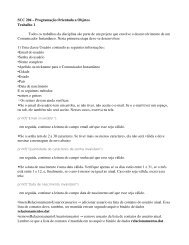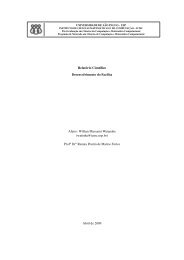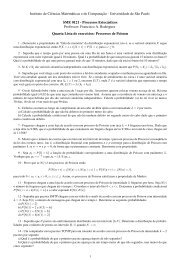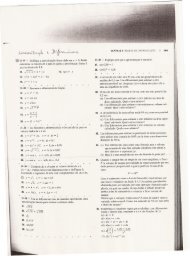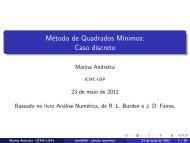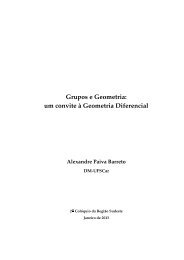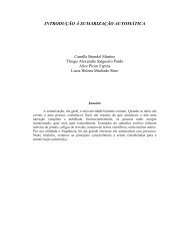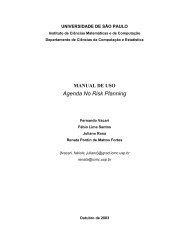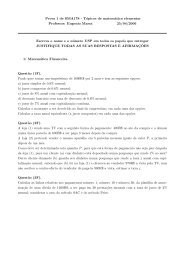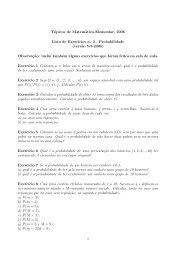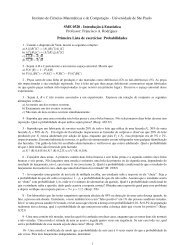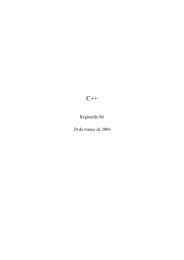Solución Numérica de la Ecuación de Calor por el ... - ICMC - USP
Solución Numérica de la Ecuación de Calor por el ... - ICMC - USP
Solución Numérica de la Ecuación de Calor por el ... - ICMC - USP
Create successful ePaper yourself
Turn your PDF publications into a flip-book with our unique Google optimized e-Paper software.
<strong>Solución</strong> <strong>Numérica</strong> <strong>de</strong> <strong>la</strong> <strong>Ecuación</strong> <strong>de</strong> <strong>Calor</strong> <strong>por</strong> <strong>el</strong> Método <strong>de</strong><br />
<strong>la</strong>s Diferencias Finitas<br />
Migu<strong>el</strong> Antonio Caro Can<strong>de</strong>zano 1 , Boris Lora Castro 1 , Val<strong>de</strong>mir Garcia Ferreira 2<br />
1 Departamento <strong>de</strong> Matemáticas <strong>de</strong> <strong>la</strong> Universidad <strong>de</strong>l Atlántico, Colombia<br />
2 Departamento <strong>de</strong> Matemática Aplicada e Estatística, <strong>ICMC</strong> - <strong>USP</strong><br />
Julio <strong>de</strong> 2008<br />
Abstract<br />
In this re<strong>por</strong>t, we present the numerical solution of the heat equation by using the finite<br />
difference method. Particu<strong>la</strong>ry, we employ an explicit and implicit schemes with diferent values<br />
of the stability parameter. The numerical results are compared with analytcal solutions.<br />
Keywords: <strong>Ecuación</strong> <strong>de</strong> calor, método <strong>de</strong> diferencias finitas, método explícito, método implícito, soluciones<br />
numéricas.<br />
1 Introducción<br />
Existen diferentes método para resolver Ecuaciones Diferenciales Parciales(EDP) y Ecuaciones Diferenciales<br />
Ordinarias(EDO), entre <strong>el</strong>los se encuentra <strong>el</strong> Método <strong>de</strong> <strong>la</strong>s Diferencias Finitas(MDF), <strong>el</strong><br />
cual consiste en introducir una mal<strong>la</strong> 1 sobre una región Ω y aproximar <strong>la</strong>s <strong>de</strong>rivadas <strong>de</strong>l problema<br />
p<strong>la</strong>nteado <strong>por</strong> medio <strong>de</strong> técnicas <strong>de</strong> aproximación <strong>de</strong> <strong>la</strong>s <strong>de</strong>rivadas como lo es, <strong>por</strong> ejemplo, <strong>la</strong> <strong>de</strong>scomposición<br />
en serie <strong>de</strong> Taylor <strong>de</strong> <strong>la</strong> función. Ahora tomemos <strong>la</strong> <strong>de</strong>scomposición en serie <strong>de</strong> Taylor<br />
<strong>de</strong> <strong>la</strong> función U en los puntos x + h y x − h, <strong>de</strong>spués sumamos como es habitual en estos casos para<br />
hal<strong>la</strong>r una expresión tanto <strong>de</strong> <strong>la</strong> primera como <strong>de</strong> <strong>la</strong> segunda <strong>de</strong>rivada <strong>de</strong> <strong>la</strong> función, entre otras, así<br />
tenemos lo siguiente<br />
U(x + h) ≈ U(x) + hU ′ (x) + h<br />
2<br />
2!<br />
U(x − h) ≈ U(x) − hU ′ (x) + h<br />
2<br />
2!<br />
U ′′ (x) + h<br />
2<br />
U<br />
3!<br />
′′′ (x) + ... (1)<br />
U ′′ (x) − h<br />
2<br />
U<br />
3!<br />
′′′ (x) + ... (2)<br />
U(x + h) + U(x − h) = 2U(x) + h 2 U ′′ (x) + O(h 4 ), (3)<br />
1 Sea U(x,t) una función <strong>de</strong> x y <strong>de</strong> t, subdividiremos <strong>el</strong> p<strong>la</strong>no x − t en un conjunto <strong>de</strong> rectángulos iguales <strong>de</strong> <strong>la</strong>dos<br />
δx y δt respectivamente, <strong>de</strong> tal manera que cada punto <strong>de</strong> los ejes OX y OY están <strong>de</strong>finidos respectivamente <strong>por</strong><br />
xi = ih,h = δx,i = ... − 1,0,1,... , yj = jk,k = δy,j = 0,1,... , así cada punto <strong>de</strong> <strong>la</strong> gril<strong>la</strong> tendrá coor<strong>de</strong>nadas<br />
(xi,yj) = (ih,jk,).Ver Fig.1.<br />
1
En (3) <strong>el</strong> error es <strong>de</strong> al menos h 4 .<br />
De lo anterior po<strong>de</strong>mos <strong>de</strong>ducir que al sumar (1) y (2) tenemos<br />
U ′′ (x) = 1<br />
h2[U(x + h) − 2U(x) + U(x − h)] (4)<br />
con un error <strong>de</strong> h 2 .<br />
Ahora <strong>de</strong> (2) restemos (3), obtenemos <strong>la</strong> <strong>de</strong>nominada diferencia central<br />
también con un error <strong>de</strong> h 2 .<br />
Definimos <strong>la</strong> “diferencia para a<strong>de</strong><strong>la</strong>nte” <strong>por</strong><br />
y <strong>la</strong> diferencia “diferencia para atrás” <strong>por</strong><br />
U ′ (x) = 1<br />
[U(x + h) − U(x − h)] (5)<br />
2h<br />
U ′ (x) = 1<br />
[U(x + h) − U(x)] (6)<br />
h<br />
U ′ (x) = 1<br />
[U(x) − U(x − h)] (7)<br />
h<br />
A continuación veamos <strong>la</strong> aplicación <strong>de</strong>l MDF en una EDO con un problema <strong>de</strong> Cauchy:<br />
<br />
u ′′ (x) + µu(x) = f(x), a ≤ x ≤ b, µ = cte<br />
u(a) = α, u(b) = β<br />
Introducimos una mal<strong>la</strong> continua en <strong>el</strong> segmento [a,b], a = x0,x1,...,xN = b, representemos <strong>la</strong><br />
segunda <strong>de</strong>rivada <strong>de</strong> u(x), aproximadamente <strong>por</strong> (3), teniendo en cuenta que un = u(xn):<br />
u ′′ (xn) ≈ un−1 − 2un + un+1<br />
h 2 , h = xn+1 − xn (9)<br />
esta aproximación se pue<strong>de</strong> utilizar en cada nodo xn, 1 ≤ n ≤ N − 1, haciendo <strong>la</strong> sustitución en (8)<br />
y representado f(xn) = fn, tenemos<br />
un−1 − 2un + un+1<br />
h 2 + µun = fn, 1 ≤ n ≤ N − 1 (10)<br />
esto es un sistema <strong>de</strong> N − 1 ecuaciones algebraicas cuyas incógnitas son <strong>la</strong>s soluciones aproximadas<br />
en cada retículo <strong>de</strong> <strong>la</strong> mal<strong>la</strong>, <strong>el</strong> número <strong>de</strong> soluciones un, 0 ≤ n ≤ N es igual a N + 1, es <strong>de</strong>cir, una<br />
más que <strong>el</strong> número <strong>de</strong> ecuaciones en <strong>el</strong> sistema (8), faltarían dos ecuaciones que pue<strong>de</strong>n ser suplidas<br />
<strong>por</strong> <strong>la</strong>s condiciones en los extremos<br />
(8)<br />
u0 = u(x0) = a, (11)<br />
uN = u(xN) = b (12)<br />
Con <strong>el</strong> sistema <strong>de</strong> ecuaciones completo, po<strong>de</strong>mos resolverlo <strong>por</strong> diferentes métodos numéricos(Gausssin<br />
Pivoteo, <strong>por</strong> ejemplo).<br />
2
2 Formu<strong>la</strong>ción <strong>de</strong>l problema<br />
Un ejemplo clásico <strong>de</strong> una EDP <strong>de</strong>l tipo parabólico es <strong>la</strong> ecuación <strong>de</strong> <strong>la</strong> distribución <strong>de</strong> calor(Difusión)<br />
en una barra <strong>de</strong> longitud L con <strong>la</strong>s particu<strong>la</strong>rida<strong>de</strong>s siguientes:<br />
• La barra esta ais<strong>la</strong>da totalmente en sus extremos.<br />
• La distribución <strong>de</strong> <strong>la</strong> temperatura es uniforme en <strong>la</strong>s secciones rectas.<br />
• El material que compone a <strong>la</strong> barra es homogéneo.<br />
La ecuación <strong>de</strong> distribución <strong>de</strong> calor tiene <strong>la</strong> siguiente forma<br />
∂U<br />
∂t = µ∂2 U<br />
, 0 < x < L, t > 0,µ − cte. (13)<br />
∂x2 don<strong>de</strong> <strong>la</strong> solución a esta ecuación es <strong>la</strong> temperatura U a una distancia X <strong>de</strong>l extremo <strong>de</strong> <strong>la</strong> barra<br />
<strong>de</strong>lgada <strong>de</strong>spués <strong>de</strong> un tiempo T, <strong>la</strong> solución es una función que <strong>de</strong>pen<strong>de</strong> <strong>de</strong> dos variables U(x,t), µ<br />
es <strong>el</strong> coeficiente <strong>de</strong> distribución <strong>de</strong> calor.<br />
3 El Método Explicito<br />
El Método Explicito consiste en calcu<strong>la</strong>r los valores <strong>de</strong>sconocidos <strong>de</strong> u en un t = k cualquiera a<br />
partir <strong>de</strong> los valores conocidos <strong>de</strong> u para valores anteriores <strong>de</strong> t, los valores <strong>de</strong> u son conocidos en<br />
t = 0,j = 0 gracias a <strong>la</strong>s condiciones iniciales. Veamos como queda (13), cuando µ = 1 utilizando<br />
MDF, para j = 0:<br />
ui,j+1 − ui,j<br />
= ui+1,j − 2ui,j + ui−1,j<br />
k<br />
h2 teniendo en cuenta que xi = ih, i = 0, 1, 2,... ,yj = jk, j = 0, 1, 2,... al operar (14) tenemos<br />
Sea r = k<br />
h2, entonces (15) toma <strong>la</strong> forma<br />
ui,j+1 = k<br />
h 2(ui+1,j − 2ui,j + ui−1,j) + ui,j<br />
ui,j+1 = rui−1,j + (1 − 2r)ui,j + rui+1,j<br />
La ecuación (16) se <strong>de</strong>nomina fórmu<strong>la</strong> explícita o mo<strong>de</strong>lo explícito para <strong>la</strong> solución <strong>de</strong> una EDP<br />
usando MDF. El Método explicito es convergente siempre que 0 < r ≤ 1<br />
h2 o que k ≤ . [3]<br />
2 2<br />
En <strong>la</strong> siguiente página encontramos un mo<strong>de</strong>lo gráfico <strong>de</strong>l Método Explícito e Implícito en forma <strong>de</strong><br />
c<strong>el</strong>u<strong>la</strong>s.<br />
3<br />
(14)<br />
(15)<br />
(16)
ui,j+1<br />
ui−1,j ui,j ui+1,j<br />
Figure 1: Célu<strong>la</strong> reticu<strong>la</strong>r para <strong>el</strong> Método Explícito<br />
i − 1,j + 1 i,j + 1 i + 1,j + 1<br />
i − 1,j i,j i + 1,j<br />
Figure 2: Célu<strong>la</strong> reticu<strong>la</strong>r para <strong>el</strong> Método Implícito<br />
4
Resolveremos una EDP parabólica utilizando para <strong>el</strong>lo <strong>el</strong> <strong>de</strong>nominado método explícito para<br />
diferentes valores <strong>de</strong> r como se indican en <strong>la</strong>s respectivas tab<strong>la</strong>s <strong>de</strong> datos. Los resultados numéricos<br />
fueron obtenidos a partir <strong>de</strong> programas hecho en <strong>el</strong> lenguaje <strong>de</strong> programación C++, en los anexos<br />
se encuentran los códigos <strong>de</strong> los programas.<br />
El problema es <strong>el</strong> siguiente:<br />
Problema 1.<br />
∂U<br />
∂t = ∂2U , 0 < x < 1, t > 0,<br />
∂x2 (17)<br />
U(x,t) = 0, si x = 0 y x = 1, ∀t > 0<br />
<br />
(18)<br />
U(x, 0) =<br />
2x, 0 ≤ x ≤ 1/2<br />
2(1 − x), 1/2 ≤ x ≤ 1<br />
(19)<br />
don<strong>de</strong> (18) son <strong>la</strong>s condiciones en <strong>la</strong> frontera, (19) son <strong>la</strong>s <strong>de</strong>nominadas condiciones iniciales.<br />
La solución analítica para <strong>el</strong> problema <strong>de</strong>scrito anteriormente es<br />
U(x,t) = 8<br />
π 2<br />
∞<br />
n=1<br />
1 nπ<br />
n2(sin 2 )(sinnπx)exp(−n2π 2 t) (20)<br />
A continuación, en <strong>la</strong> siguiente página, mostramos <strong>la</strong>s soluciones numéricas <strong>de</strong>l Problema 1. para<br />
diferentes valores <strong>de</strong> r 2 . El error lo <strong>de</strong>finimos <strong>por</strong> <strong>la</strong> siguiente fórmu<strong>la</strong> [4]<br />
error = |U(xi,yj) − U(x,y)|<br />
U(x,y)<br />
× 100. (21)<br />
La Diferencia se <strong>de</strong>fine <strong>por</strong> <strong>la</strong> resta entre <strong>el</strong> valor numérico <strong>de</strong> <strong>la</strong> función U(xi,yj) obtenido <strong>por</strong> <strong>el</strong><br />
MDF y <strong>el</strong> valor analítico <strong>de</strong> <strong>la</strong> misma U(x,y).<br />
2 Los resultados numéricos <strong>de</strong> los problemas analizados y presentados en este trabajo son para los siguientes casos:<br />
r = 0.48, r = 0.50, r = 0.30, r = 0.70. En <strong>la</strong>s Tab<strong>la</strong>s Dif significa Diferencia.<br />
5
Tab<strong>la</strong> 1: Resultados Numéricos <strong>de</strong>l Problema 1. aplicando <strong>el</strong> Método Explícito.<br />
Caso 1. 1.r = 0.30,h = 0.1,k = 0.0030<br />
i j x t u(x i,t j) U(x,t) Dif Error<br />
1 2 0.100 0.006 0.2000 0.2000 0.0000 0.0069<br />
2 2 0.200 0.006 0.4000 0.3996 0.0004 0.1024<br />
3 2 0.300 0.006 0.6000 0.5941 0.0059 0.9865<br />
4 2 0.400 0.006 0.7640 0.7570 0.0070 0.9218<br />
5 2 0.500 0.006 0.8320 0.8252 0.0068 0.8250<br />
.<br />
.<br />
.<br />
.<br />
.<br />
1 10 0.100 0.030 0.1829 0.1812 0.0016 0.9081<br />
2 10 0.200 0.030 0.3512 0.3484 0.0028 0.8046<br />
3 10 0.300 0.030 0.4890 0.4857 0.0033 0.6724<br />
4 10 0.400 0.030 0.5803 0.5770 0.0032 0.5621<br />
5 10 0.500 0.030 0.6123 0.6091 0.0032 0.5193<br />
.<br />
.<br />
.<br />
.<br />
.<br />
1 30 0.100 0.090 0.1033 0.1030 0.0002 0.2409<br />
2 30 0.200 0.090 0.1964 0.1960 0.0005 0.2376<br />
3 30 0.300 0.090 0.2704 0.2698 0.0006 0.2334<br />
4 30 0.400 0.090 0.3179 0.3171 0.0007 0.2301<br />
5 30 0.500 0.090 0.3342 0.3335 0.0008 0.2288<br />
.<br />
.<br />
.<br />
.<br />
.<br />
1 38 0.100 0.114 0.0814 0.0813 0.0001 0.0758<br />
2 38 0.200 0.114 0.1548 0.1547 0.0001 0.0752<br />
3 38 0.300 0.114 0.2130 0.2129 0.0002 0.0744<br />
4 38 0.400 0.114 0.2504 0.2502 0.0002 0.0738<br />
5 38 0.500 0.114 0.2633 0.2631 0.0002 0.0736<br />
Caso 3. r = 0.50, h = 0.1, k = 0.0050<br />
i j x t u(x i,t j) U(x,t) Dif Error<br />
1 1 0.100 0.005 0.2000 0.2000 0.0000 0.0014<br />
2 1 0.200 0.005 0.4000 0.3998 0.0002 0.0382<br />
3 1 0.300 0.005 0.6000 0.5966 0.0034 0.5693<br />
4 1 0.400 0.005 0.8000 0.7667 0.0333 4.3469<br />
5 1 0.500 0.005 0.8000 0.8404 0.0404 4.8099<br />
.<br />
.<br />
.<br />
.<br />
.<br />
1 6 0.100 0.030 0.1875 0.1812 0.0063 3.4570<br />
2 6 0.200 0.030 0.3438 0.3484 0.0046 1.3281<br />
3 6 0.300 0.030 0.5000 0.4857 0.0143 2.9338<br />
4 6 0.400 0.030 0.5625 0.5770 0.0145 2.5161<br />
5 6 0.500 0.030 0.6250 0.6091 0.0159 2.6058<br />
.<br />
.<br />
.<br />
.<br />
.<br />
1 18 0.100 0.090 0.10490 0.1030 0.0019 1.8338<br />
2 18 0.200 0.090 0.18978 0.1960 0.0062 3.1551<br />
3 18 0.300 0.090 0.27466 0.2698 0.0049 1.8188<br />
4 18 0.400 0.090 0.30708 0.3171 0.0101 3.1715<br />
5 18 0.500 0.090 0.33951 0.3335 0.0060 1.8096<br />
.<br />
.<br />
.<br />
.<br />
.<br />
1 24 0.100 0.120 0.07764 0.0766 0.0010 1.3101<br />
2 24 0.200 0.120 0.14044 0.1458 0.0053 3.6490<br />
3 24 0.300 0.120 0.20325 0.2006 0.0026 1.3085<br />
4 24 0.400 0.120 0.22724 0.2359 0.0086 3.6506<br />
5 24 0.500 0.120 0.25123 0.2480 0.0032 1.3075<br />
.<br />
.<br />
.<br />
.<br />
.<br />
.<br />
.<br />
.<br />
.<br />
.<br />
.<br />
.<br />
.<br />
.<br />
.<br />
.<br />
.<br />
.<br />
6<br />
Caso 1. 2.r = 0.48,h = 0.1,k = 0.0048<br />
i j x t u(x i,t j) U(x,t) Dif Error<br />
1 1 0.100 0.005 0.2000 0.2000 0.0000 0.0010<br />
2 1 0.200 0.005 0.4000 0.3999 0.0001 0.0300<br />
3 1 0.300 0.005 0.6000 0.5970 0.0030 0.4987<br />
4 1 0.400 0.005 0.8000 0.7686 0.0314 4.0841<br />
5 1 0.500 0.005 0.8080 0.8436 0.0356 4.2254<br />
.<br />
.<br />
.<br />
.<br />
.<br />
1 5 0.100 0.024 0.1898 0.1891 0.0007 0.3766<br />
2 5 0.200 0.024 0.3754 0.3658 0.0096 2.6170<br />
3 5 0.300 0.024 0.5093 0.5141 0.0048 0.9356<br />
4 5 0.400 0.024 0.6261 0.6146 0.0115 1.8742<br />
5 5 0.500 0.024 0.6389 0.6504 0.0115 1.7648<br />
.<br />
.<br />
.<br />
.<br />
.<br />
1 20 0.100 0.096 0.0969 0.0971 0.0002 0.2344<br />
2 20 0.200 0.096 0.1827 0.1847 0.0020 1.1016<br />
3 20 0.300 0.096 0.2536 0.2542 0.0006 0.2441<br />
4 20 0.400 0.096 0.2956 0.2989 0.0033 1.1113<br />
5 20 0.500 0.096 0.3135 0.3143 0.0008 0.2501<br />
.<br />
.<br />
.<br />
.<br />
.<br />
1 25 0.100 0.120 0.0756 0.0766 0.0010 1.3250<br />
2 25 0.200 0.120 0.1446 0.1458 0.0011 0.7712<br />
3 25 0.300 0.120 0.1980 0.2006 0.0027 1.3266<br />
4 25 0.400 0.120 0.2340 0.2359 0.0018 0.7728<br />
5 25 0.500 0.120 0.2447 0.2480 0.0033 1.3276<br />
Caso 4. r = 0.70, h = 0.1, k = 0.0070<br />
i j x t u(x i,t j) U(x,t) Dif Error<br />
1 1 0.100 0.007 0.2000 0.2000 0.0000 0.022<br />
2 1 0.200 0.007 0.4000 0.3992 0.0008 0.212<br />
3 1 0.300 0.007 0.6000 0.5911 0.0089 1.491<br />
4 1 0.400 0.007 0.8000 0.7475 0.0525 7.023<br />
5 1 0.500 0.007 0.7200 0.8112 0.0912 11.24<br />
.<br />
.<br />
.<br />
.<br />
.<br />
1 5 0.100 0.035 0.1328 0.1741 0.0413 23.73<br />
2 5 0.200 0.035 0.4576 0.3335 0.1242 37.24<br />
3 5 0.300 0.035 0.2268 0.4630 0.2362 51.01<br />
4 5 0.400 0.035 0.8898 0.5481 0.3417 62.34<br />
5 5 0.500 0.035 0.1860 0.5778 0.3918 67.80<br />
.<br />
.<br />
.<br />
.<br />
.<br />
1 8 0.100 0.056 0.5529 0.1436 0.4093 285.00<br />
2 8 0.200 0.056 -0.582 0.2735 0.8551 312.58<br />
3 8 0.300 0.056 1.6757 0.3771 1.2985 344.31<br />
4 8 0.400 0.056 -1.209 0.4439 1.6526 372.26<br />
5 8 0.500 0.056 2.2456 0.4670 1.7786 380.82<br />
.<br />
.<br />
.<br />
.<br />
.<br />
1 11 0.100 0.077 -2.355 0.1171 2.4718 2111.4<br />
2 11 0.200 0.077 5.0544 0.2227 4.8317 2169.3<br />
3 11 0.300 0.077 -6.582 0.3067 6.8883 2246.2<br />
4 11 0.400 0.077 8.6683 0.3606 8.3077 2303.9<br />
5 11 0.500 0.077 -8.454 0.3793 8.8329 2329.4<br />
.<br />
.<br />
.<br />
.<br />
.<br />
.<br />
.<br />
.<br />
.<br />
.<br />
.<br />
.<br />
.<br />
.<br />
.<br />
.<br />
.<br />
.
U(x,t)<br />
U(x,t)<br />
2<br />
1.5<br />
1<br />
0.5<br />
Cuadro <strong>de</strong> comparacion entre <strong>la</strong>s soluciones aproximadas y analiticas <strong>por</strong> <strong>el</strong> MDF para <strong>el</strong> caso 1. r=0.30<br />
0<br />
0 0.2 0.4 0.6 0.8 1<br />
2<br />
1.5<br />
1<br />
0.5<br />
x<br />
Solucion aproximada<br />
Solucion analitica<br />
Cuadro <strong>de</strong> comparacion entre <strong>la</strong>s soluciones aproximadas y analiticas <strong>por</strong> <strong>el</strong> MDF para <strong>el</strong> caso 3. r=0.50<br />
0<br />
0 0.2 0.4 0.6 0.8 1<br />
x<br />
Solucion aproximada<br />
Solucion analitica<br />
U(x,t)<br />
U(x,t)<br />
2<br />
1.5<br />
1<br />
0.5<br />
Cuadro <strong>de</strong> comparacion entre <strong>la</strong>s soluciones aproximadas y analiticas <strong>por</strong> <strong>el</strong> MDF para <strong>el</strong> caso 2. r=0.48<br />
0<br />
0 0.2 0.4 0.6 0.8 1<br />
2<br />
1.5<br />
1<br />
0.5<br />
x<br />
Solucion aproximada<br />
Solucion analitica<br />
Cuadro <strong>de</strong> comparacion entre <strong>la</strong>s soluciones aproximadas y analiticas <strong>por</strong> <strong>el</strong> MDF para <strong>el</strong> caso 4. r=0.70<br />
0<br />
0 0.2 0.4 0.6 0.8 1<br />
x<br />
Solucion aproximada<br />
Solucion analitica<br />
Figure 3: Tab<strong>la</strong>s <strong>de</strong> comparación entre <strong>la</strong>s soluciones analíticas y aproximadas <strong>por</strong> <strong>el</strong><br />
Método Explícito<br />
7
Ahora analicemos un problema simi<strong>la</strong>r al Problema 1. pero empleando <strong>de</strong>rivadas en <strong>la</strong>s condiciones<br />
<strong>de</strong> frontera<br />
Problema 2.<br />
∂U<br />
∂t = ∂2U , 0 < x < 1, t > 0,<br />
∂x2 (22)<br />
U(x, 0) = 1, 0 ≤ x ≤ 1<br />
⎧<br />
∂U<br />
⎪⎨<br />
= U, x = 0, ∀t<br />
∂x<br />
⎪⎩ ∂U<br />
= −U, x = 1, ∀t<br />
∂x<br />
(23)<br />
(24)<br />
Usemos <strong>el</strong> MDF en <strong>el</strong> problema y expresemos <strong>la</strong>s condiciones <strong>de</strong> frontera mediante <strong>la</strong>s diferencias<br />
centrales, <strong>de</strong> tal manera que (22) queda así<br />
Apliquemos (25) para x = 0, cuando i = 0<br />
ui,j+1 = ui,j + r(ui−1,j − 2ui,j + ui+1,j). (25)<br />
u0,j+1 = u0,j + r(u−1,j − 2u0,j + u1,j). (26)<br />
Para <strong>la</strong> condición <strong>de</strong> frontera en x = 0, en términos <strong>de</strong>l MDF es<br />
u1,j − u−1,j<br />
2h<br />
= u0,j. (27)<br />
De (25) y (26) <strong>el</strong>iminamos u−1,j, y <strong>la</strong> expresión en este caso es<br />
u0,j+1 = u0,j + 2r(u1,j − (1 + h)u0,j). (28)<br />
Actuamos <strong>de</strong> <strong>la</strong> misma manera con <strong>la</strong> otra condición <strong>de</strong>l valor <strong>de</strong> frontera en x = 1, cuando i = 10<br />
u10,j+1 = u10,j + r(u9,j − 2u10,j + u11,j), (29)<br />
también <strong>el</strong>iminamos <strong>el</strong> valor u11,j, <strong>el</strong> cual no existe según <strong>el</strong> p<strong>la</strong>nteamiento <strong>de</strong> nuestro problema, <strong>por</strong><br />
eso expresemos (24) usando MDF<br />
u11,j − u9,j<br />
2h<br />
así tenemos que al excluir u11,j <strong>de</strong> (30), tenemos<br />
= −u10,j, (30)<br />
u10,j+1 = u10,j + 2r(u9,j − (1 + h)u10,j). (31)<br />
Po<strong>de</strong>mos resumir <strong>la</strong> expresión en diferencias <strong>de</strong>l Problema 2. en estas tres expresiones<br />
⎧<br />
⎪⎨ ui,j+1 = ui,j + r(ui−1,j − 2ui,j + ui+1,j)<br />
u0,j+1 = u0,j + 2r(u1,j − (1 + h)u0,j).<br />
⎪⎩<br />
u10,j+1 = u10,j + 2r(u9,j − (1 + h)u10,j)<br />
8<br />
(32)
La solución analítica <strong>de</strong>l Problema 2. es<br />
∞<br />
<br />
sec αn<br />
U(x,t) = 4<br />
(3 + 4α2 n) exp (−4α2 nt) cos(2αn(x − 1<br />
2 ))<br />
<br />
αn son <strong>la</strong>s raíces positivas <strong>de</strong><br />
n=1<br />
α tan α = 1<br />
2<br />
Hay que tener presente que tanto en <strong>el</strong> Problema 1. como en <strong>el</strong> Problema 2., con respecto a x = 1<br />
2 ,<br />
existe una simetría, <strong>la</strong> cual facilita, en este caso en particu<strong>la</strong>r, <strong>el</strong> cálculo numérico.<br />
Se ha <strong>de</strong>mostrado que <strong>el</strong> esquema utilizado para <strong>el</strong> Problema 2. es convergente [3] siempre que<br />
r ≤ 1<br />
2+hδx .<br />
En <strong>la</strong> siguiente página mostramos <strong>la</strong>s Tab<strong>la</strong>s que muestran los resultados numéricos para <strong>el</strong> Problema<br />
2.<br />
9<br />
(33)<br />
(34)
Tab<strong>la</strong> 2: Resultados Numéricos <strong>de</strong>l Problema 2. aplicando <strong>el</strong> Método Explicito.<br />
Caso 1. r = 0.30,h = 0.1,k = 0.0030<br />
i j x t u(x i,t j) U(x,t) Dif Error<br />
0 1 0.0000 0.0030 0.9400 0.9411 0.0011 0.11<br />
1 1 0.1000 0.0030 1.0000 0.9930 0.0070 0.70<br />
2 1 0.2000 0.0030 1.0000 0.9998 0.0002 0.02<br />
3 1 0.3000 0.0030 1.0000 1.0000 0.0000 0.00<br />
4 1 0.4000 0.0030 1.0000 1.0000 0.0000 0.00<br />
5 1 0.5000 0.0030 1.0000 1.0000 0.0000 0.00<br />
.<br />
.<br />
.<br />
.<br />
.<br />
0 10 0.0000 0.0300 0.8308 0.8311 0.0002 0.03<br />
1 10 0.1000 0.0300 0.9021 0.9018 0.0003 0.03<br />
2 10 0.2000 0.0300 0.9496 0.9488 0.0008 0.08<br />
3 10 0.3000 0.0300 0.9772 0.9761 0.0011 0.12<br />
4 10 0.4000 0.0300 0.9906 0.9893 0.0013 0.13<br />
5 10 0.5000 0.0300 0.9944 0.9931 0.0013 0.13<br />
.<br />
.<br />
.<br />
.<br />
.<br />
0 34 0.0000 0.1020 0.7148 0.7150 0.0002 0.03<br />
1 34 0.1000 0.1020 0.7800 0.7800 0.0000 0.00<br />
2 34 0.2000 0.1020 0.8316 0.8313 0.0002 0.03<br />
3 34 0.3000 0.1020 0.8688 0.8683 0.0004 0.05<br />
4 34 0.4000 0.1020 0.8912 0.8906 0.0006 0.06<br />
5 34 0.5000 0.1020 0.8987 0.8981 0.0006 0.07<br />
.<br />
.<br />
.<br />
.<br />
.<br />
0 68 0.0000 0.2040 0.5995 0.5999 0.0004 0.07<br />
1 68 0.1000 0.2040 0.6543 0.6546 0.0003 0.05<br />
2 68 0.2000 0.2040 0.6979 0.6981 0.0002 0.03<br />
3 68 0.3000 0.2040 0.7297 0.7298 0.0001 0.02<br />
4 68 0.4000 0.2040 0.7489 0.7490 0.0001 0.01<br />
5 68 0.5000 0.2040 0.7554 0.7554 0.0001 0.01<br />
Caso 3. r = 0.50,h = 0.1,k = 0.0050<br />
i j x t u(x i,t j) U(x,t) Dif Error<br />
0 1 0.0000 0.0050 0.9000 0.9250 0.0250 2.70<br />
1 1 0.1000 0.0050 1.0000 0.9841 0.0159 1.62<br />
2 1 0.2000 0.0050 1.0000 0.9984 0.0016 0.16<br />
3 1 0.3000 0.0050 1.0000 0.9999 0.0001 0.01<br />
4 1 0.4000 0.0050 1.0000 1.0000 0.0000 0.00<br />
5 1 0.5000 0.0050 1.0000 1.0000 0.0000 0.00<br />
.<br />
.<br />
.<br />
.<br />
.<br />
0 4 0.0000 0.0200 0.8691 0.8585 0.0106 1.24<br />
1 4 0.1000 0.0200 0.9170 0.9286 0.0116 1.24<br />
2 4 0.2000 0.0200 0.9775 0.9695 0.0080 0.83<br />
3 4 0.3000 0.0200 0.9875 0.9891 0.0016 0.16<br />
4 4 0.4000 0.0200 1.0000 0.9967 0.0033 0.33<br />
5 4 0.5000 0.0200 1.0000 0.9985 0.0015 0.15<br />
.<br />
.<br />
.<br />
.<br />
.<br />
0 20 0.0000 0.1000 0.7260 0.7176 0.0085 1.18<br />
1 20 0.1000 0.1000 0.7741 0.7828 0.0086 1.10<br />
2 20 0.2000 0.1000 0.8416 0.8342 0.0074 0.89<br />
3 20 0.3000 0.1000 0.8646 0.8713 0.0067 0.77<br />
4 20 0.4000 0.1000 0.9007 0.8936 0.0071 0.79<br />
5 20 0.5000 0.1000 0.8952 0.9011 0.0059 0.65<br />
.<br />
.<br />
.<br />
.<br />
.<br />
0 41 0.0000 0.2050 0.5868 0.5989 0.0121 2.02<br />
1 41 0.1000 0.2050 0.6631 0.6535 0.0096 1.47<br />
2 41 0.2000 0.2050 0.6868 0.6970 0.0102 1.46<br />
3 41 0.3000 0.2050 0.7370 0.7285 0.0085 1.16<br />
4 41 0.4000 0.2050 0.7385 0.7477 0.0092 1.24<br />
5 41 0.5000 0.2050 0.7622 0.7541 0.0081 1.07<br />
.<br />
.<br />
.<br />
.<br />
.<br />
.<br />
.<br />
.<br />
.<br />
.<br />
.<br />
.<br />
.<br />
.<br />
.<br />
.<br />
.<br />
.<br />
10<br />
Caso 2. r = 0.48,h = 0.1,k = 0.0048<br />
i j x t u(x i,t j) U(x,t) Dif Error<br />
0 1 0.0000 0.0048 0.9040 0.9264 0.0224 2.42<br />
1 1 0.1000 0.0048 1.0000 0.9850 0.0150 1.53<br />
2 1 0.2000 0.0048 1.0000 0.9986 0.0014 0.14<br />
3 1 0.3000 0.0048 1.0000 0.9999 0.0001 0.01<br />
4 1 0.4000 0.0048 1.0000 1.0000 0.0000 0.00<br />
5 1 0.5000 0.0048 1.0000 1.0000 0.0000 0.00<br />
.<br />
.<br />
.<br />
.<br />
.<br />
0 5 0.0000 0.0240 0.8372 0.8467 0.0095 1.12<br />
1 5 0.1000 0.0240 0.9227 0.9172 0.0055 0.60<br />
2 5 0.2000 0.0240 0.9569 0.9610 0.0041 0.43<br />
3 5 0.3000 0.0240 0.9887 0.9841 0.0046 0.46<br />
4 5 0.4000 0.0240 0.9949 0.9942 0.0007 0.07<br />
5 5 0.5000 0.0240 1.0000 0.9968 0.0032 0.32<br />
.<br />
.<br />
.<br />
.<br />
.<br />
0 21 0.0000 0.1008 0.7144 0.7165 0.0021 0.30<br />
1 21 0.1000 0.1008 0.7828 0.7817 0.0011 0.14<br />
2 21 0.2000 0.1008 0.8317 0.8331 0.0014 0.17<br />
3 21 0.3000 0.1008 0.8716 0.8701 0.0015 0.17<br />
4 21 0.4000 0.1008 0.8917 0.8924 0.0007 0.08<br />
5 21 0.5000 0.1008 0.9016 0.8999 0.0017 0.19<br />
.<br />
.<br />
.<br />
.<br />
.<br />
0 42 0.0000 0.2016 0.6020 0.6024 0.0004 0.06<br />
1 42 0.1000 0.2016 0.6563 0.6573 0.0010 0.15<br />
2 42 0.2000 0.2016 0.7007 0.7010 0.0003 0.04<br />
3 42 0.3000 0.2016 0.7320 0.7328 0.0008 0.11<br />
4 42 0.4000 0.2016 0.7519 0.7521 0.0002 0.03<br />
5 42 0.5000 0.2016 0.7578 0.7585 0.0007 0.10<br />
Caso 4. r = 0.70,h = 0.1,k = 0.0070<br />
i j x t u(x i,t j) U(x,t) Dif Error<br />
0 1 0.0000 0.0070 0.8600 0.9122 0.0522 5.72<br />
1 1 0.1000 0.0070 1.0000 0.9752 0.0248 2.55<br />
2 1 0.2000 0.0070 1.0000 0.9958 0.0042 0.43<br />
3 1 0.3000 0.0070 1.0000 0.9996 0.0004 0.04<br />
4 1 0.4000 0.0070 1.0000 1.0000 0.0000 0.00<br />
5 1 0.5000 0.0070 1.0000 1.0000 0.0000 0.00<br />
.<br />
.<br />
.<br />
.<br />
.<br />
0 3 0.0000 0.0210 0.7576 0.8554 0.0978 11.44<br />
1 3 0.1000 0.0210 0.9941 0.9256 0.0685 7.40<br />
2 3 0.2000 0.0210 0.9314 0.9673 0.0359 3.71<br />
3 3 0.3000 0.0210 1.0000 0.9879 0.0121 1.22<br />
4 3 0.4000 0.0210 1.0000 0.9961 0.0039 0.39<br />
5 3 0.5000 0.0210 1.0000 0.9981 0.0019 0.19<br />
.<br />
.<br />
.<br />
.<br />
.<br />
0 15 0.0000 0.1050 -62.0875 0.7113 62.7987 8829.33<br />
1 15 0.1000 0.1050 56.4138 0.7759 55.6379 7170.53<br />
2 15 0.2000 0.1050 -46.6049 0.8270 47.4319 5735.09<br />
3 15 0.3000 0.1050 40.5358 0.8639 39.6718 4592.03<br />
4 15 0.4000 0.1050 -33.2094 0.8862 34.0956 3847.51<br />
5 15 0.5000 0.1050 32.9599 0.8936 32.0663 3588.42<br />
.<br />
.<br />
.<br />
.<br />
.<br />
0 29 0.0000 0.2030 -234318 0.6009 234319 38992788<br />
1 29 0.1000 0.2030 212842 0.6557 212841 32458883<br />
2 29 0.2000 0.2030 -195210 0.6993 195211 27913594<br />
3 29 0.3000 0.2030 181872 0.7310 181871 24878652<br />
4 29 0.4000 0.2030 -173483 0.7503 173484 23123068<br />
5 29 0.5000 0.2030 170616 0.7567 170615 22546964<br />
.<br />
.<br />
.<br />
.<br />
.<br />
.<br />
.<br />
.<br />
.<br />
.<br />
.<br />
.<br />
.<br />
.<br />
.<br />
.<br />
.<br />
.
U(x,t)<br />
U(x,t)<br />
2<br />
1.5<br />
1<br />
0.5<br />
Cuadro <strong>de</strong> comparacion entre <strong>la</strong>s soluciones aproximadas y analiticas <strong>por</strong> <strong>el</strong> MDF para <strong>el</strong> caso 1. r=0.30<br />
0<br />
0 0.2 0.4 0.6 0.8 1<br />
2<br />
1.5<br />
1<br />
0.5<br />
x<br />
Solucion aproximada<br />
Solucion analitica<br />
Cuadro <strong>de</strong> comparacion entre <strong>la</strong>s soluciones aproximadas y analiticas <strong>por</strong> <strong>el</strong> MDF para <strong>el</strong> caso 3. r=0.50<br />
0<br />
0 0.2 0.4 0.6 0.8 1<br />
x<br />
Solucion aproximada<br />
Solucion analitica<br />
U(x,t)<br />
U(x,t)<br />
2<br />
1.5<br />
1<br />
0.5<br />
Cuadro <strong>de</strong> comparacion entre <strong>la</strong>s soluciones aproximadas y analiticas <strong>por</strong> <strong>el</strong> MDF para <strong>el</strong> caso 2. r=0.48<br />
0<br />
0 0.2 0.4 0.6 0.8 1<br />
2<br />
1.5<br />
1<br />
0.5<br />
x<br />
Solucion aproximada<br />
Solucion analitica<br />
Cuadro <strong>de</strong> comparacion entre <strong>la</strong>s soluciones aproximadas y analiticas <strong>por</strong> <strong>el</strong> MDF para <strong>el</strong> caso 4. r=0.70<br />
0<br />
0 0.2 0.4 0.6 0.8 1<br />
x<br />
Solucion aproximada<br />
Solucion analitica<br />
Figure 4: Cuadros <strong>de</strong> comparación entre <strong>la</strong>s soluciones analíticas y aproximadas <strong>por</strong> <strong>el</strong><br />
Método Explícito para <strong>el</strong> Problema 2.<br />
11
En <strong>la</strong> tab<strong>la</strong> anterior observamos que para <strong>el</strong> caso r= 0.70, <strong>el</strong> proceso es divergente.<br />
4 El Método Implicito Crank-Nicolson<br />
Este método consiste en analizar <strong>la</strong> EDP en <strong>el</strong> punto (ih, (j + 1)k)<br />
y aproximar <strong>la</strong> <strong>de</strong>rivada con<br />
2<br />
respecto al tiempo <strong>por</strong> <strong>la</strong> diferencia central y <strong>la</strong> <strong>de</strong>rivada con respecto a x <strong>por</strong> <strong>la</strong> media <strong>de</strong> <strong>la</strong>s<br />
diferencias centrales en los niv<strong>el</strong>es <strong>de</strong> tiempo j, j +1. Según este método <strong>el</strong> problema (13) se expresa<br />
en MDF así:<br />
ui,j+1 − ui,j<br />
=<br />
k<br />
1<br />
<br />
ui+1,j+1 − 2ui,j+1 + ui−1,j+1<br />
2 h2 + ui+1,j − 2ui,j + ui−1,j<br />
h2 <br />
. (35)<br />
Al operar (35) tenemos<br />
−rui−1,j+1 + (2 + 2r)ui,j+1 − rui+1,j+1 = rui−1,j + (2 − 2r)ui,j + rui+1,j, r = k<br />
h 2<br />
D<strong>el</strong> <strong>la</strong>do izquierdo <strong>de</strong> (36) hay tres valores <strong>de</strong>sconocidos y <strong>de</strong>l <strong>la</strong>do <strong>de</strong>recho tres conocidos. Para<br />
cada valor <strong>de</strong> t > 0, o j > 1, se forman N ecuaciones simultaneas con N incógnitas, este sistema<br />
pue<strong>de</strong> ser resu<strong>el</strong>to , <strong>por</strong> ejemplo, <strong>por</strong> <strong>el</strong> Método <strong>de</strong> Gauss sin pivoteo.(Dibujar <strong>la</strong> célu<strong>la</strong>)<br />
Ahora resolvemos <strong>el</strong> Problema 1. <strong>por</strong> <strong>el</strong> método Crank-Nicolson; en <strong>la</strong> siguiente página mostramos<br />
los resultados numéricos para los distintos casos <strong>de</strong> r <strong>de</strong>terminados en <strong>la</strong>s anteriores tab<strong>la</strong>s.<br />
12<br />
(36)
Tab<strong>la</strong> 3: Resultados Numéricos <strong>de</strong>l Problema 1. aplicando <strong>el</strong> Método Implícito.<br />
Caso 1. r = 0.30,h = 0.1,k = 0.0030<br />
i j x t u(x i,t j) U(x,t) Dif Error<br />
1 1 0.1000 0.0030 0.1995 0.2000 0.0005 0.2354<br />
2 1 0.2000 0.0030 0.3981 0.4000 0.0019 0.4698<br />
3 1 0.3000 0.0030 0.5929 0.5995 0.0066 1.0978<br />
4 1 0.4000 0.0030 0.7736 0.7856 0.0120 1.5255<br />
5 1 0.5000 0.0030 0.9016 0.8764 0.0252 2.8773<br />
.<br />
.<br />
.<br />
.<br />
.<br />
1 6 0.1000 0.0180 0.1770 0.1954 0.0183 9.3795<br />
2 6 0.2000 0.0180 0.3435 0.3816 0.0381 9.9848<br />
3 6 0.3000 0.0180 0.4874 0.5430 0.0557 10.2494<br />
4 6 0.4000 0.0180 0.5953 0.6561 0.0608 9.2634<br />
5 6 0.5000 0.0180 0.6549 0.6972 0.0423 6.0700<br />
.<br />
.<br />
.<br />
.<br />
.<br />
1 11 0.1000 0.0330 0.1410 0.1770 0.0359 20.3029<br />
2 11 0.2000 0.0330 0.2714 0.3394 0.0680 20.0451<br />
3 11 0.3000 0.0330 0.3809 0.4720 0.0911 19.3023<br />
4 11 0.4000 0.0330 0.4606 0.5594 0.0989 17.6717<br />
5 11 0.5000 0.0330 0.5037 0.5901 0.0864 14.6436<br />
.<br />
.<br />
.<br />
.<br />
.<br />
1 15 0.1000 0.0450 0.1156 0.1593 0.0437 27.4318<br />
2 15 0.2000 0.0450 0.2222 0.3040 0.0818 26.9190<br />
3 15 0.3000 0.0450 0.3113 0.4201 0.1088 25.9009<br />
4 15 0.4000 0.0450 0.3758 0.4954 0.1196 24.1373<br />
5 15 0.5000 0.0450 0.4106 0.5215 0.1109 21.2652<br />
Caso 3. r = 0.50,h = 0.1,k = 0.0050<br />
i j x t u(x i,t j) U(x,t) Dif Error<br />
1 1 0.1000 0.0050 0.1993 0.2000 0.0007 0.3488<br />
2 1 0.2000 0.0050 0.3972 0.3998 0.0026 0.6626<br />
3 1 0.3000 0.0050 0.5895 0.5966 0.0071 1.1920<br />
4 1 0.4000 0.0050 0.7608 0.7667 0.0059 0.7700<br />
5 1 0.5000 0.0050 0.8536 0.8404 0.0132 1.5667<br />
.<br />
.<br />
.<br />
.<br />
.<br />
1 4 0.1000 0.0200 0.1836 0.1935 0.0099 5.1057<br />
2 4 0.2000 0.0200 0.3563 0.3766 0.0203 5.3891<br />
3 4 0.3000 0.0200 0.5042 0.5334 0.0291 5.4602<br />
4 4 0.4000 0.0200 0.6105 0.6418 0.0313 4.8731<br />
5 4 0.5000 0.0200 0.6590 0.6808 0.0218 3.2038<br />
.<br />
.<br />
.<br />
.<br />
.<br />
1 12 0.1000 0.0600 0.1130 0.1382 0.0252 18.2645<br />
2 12 0.2000 0.0600 0.2159 0.2631 0.0472 17.9370<br />
3 12 0.3000 0.0600 0.2997 0.3626 0.0628 17.3302<br />
4 12 0.4000 0.0600 0.3569 0.4267 0.0697 16.3473<br />
5 12 0.5000 0.0600 0.3822 0.4488 0.0665 14.8286<br />
.<br />
.<br />
.<br />
.<br />
.<br />
1 20 0.1000 0.1000 0.0666 0.0933 0.0267 28.6218<br />
2 20 0.2000 0.1000 0.1273 0.1776 0.0502 28.2939<br />
3 20 0.3000 0.1000 0.1767 0.2444 0.0677 27.7122<br />
4 20 0.4000 0.1000 0.2103 0.2873 0.0770 26.8120<br />
5 20 0.5000 0.1000 0.2252 0.3021 0.0769 25.4701<br />
.<br />
.<br />
.<br />
.<br />
.<br />
.<br />
.<br />
.<br />
.<br />
.<br />
.<br />
.<br />
.<br />
.<br />
.<br />
.<br />
.<br />
.<br />
13<br />
Caso 2. r = 0.48,h = 0.1,k = 0.0048<br />
i j x t u(x i,t j) U(x,t) Dif Error<br />
1 1 0.1000 0.0048 0.1993 0.2000 0.0007 0.3389<br />
2 1 0.2000 0.0048 0.3973 0.3999 0.0026 0.6499<br />
3 1 0.3000 0.0048 0.5898 0.5970 0.0072 1.2092<br />
4 1 0.4000 0.0048 0.7619 0.7686 0.0067 0.8688<br />
5 1 0.5000 0.0048 0.8579 0.8436 0.0143 1.6922<br />
.<br />
.<br />
.<br />
.<br />
.<br />
1 5 0.1000 0.0240 0.1756 0.1891 0.0135 7.1315<br />
2 5 0.2000 0.0240 0.3391 0.3658 0.0267 7.2965<br />
3 5 0.3000 0.0240 0.4770 0.5141 0.0371 7.2208<br />
4 5 0.4000 0.0240 0.5746 0.6146 0.0400 6.5085<br />
5 5 0.5000 0.0240 0.6194 0.6504 0.0310 4.7622<br />
.<br />
.<br />
.<br />
.<br />
.<br />
1 9 0.1000 0.0432 0.1389 0.1620 0.0231 14.2364<br />
2 9 0.2000 0.0432 0.2660 0.3092 0.0433 13.9879<br />
3 9 0.3000 0.0432 0.3700 0.4275 0.0575 13.4496<br />
4 9 0.4000 0.0432 0.4416 0.5044 0.0628 12.4537<br />
5 9 0.5000 0.0432 0.4739 0.5311 0.0572 10.7737<br />
.<br />
.<br />
.<br />
.<br />
.<br />
1 17 0.1000 0.0816 0.0832 0.1119 0.0287 25.6877<br />
2 17 0.2000 0.0816 0.1590 0.2129 0.0539 25.3273<br />
3 17 0.3000 0.0816 0.2207 0.2931 0.0723 24.6839<br />
4 17 0.4000 0.0816 0.2630 0.3446 0.0816 23.6810<br />
5 17 0.5000 0.0816 0.2820 0.3623 0.0804 22.1768<br />
Caso 4. r = 0.70,h = 0.1,k = 0.0070<br />
i j x t u(x i,t j) U(x,t) Dif Error<br />
1 1 0.1000 0.0070 0.1991 0.2000 0.0008 0.4209<br />
2 1 0.2000 0.0070 0.3965 0.3992 0.0027 0.6749<br />
3 1 0.3000 0.0070 0.5867 0.5911 0.0044 0.7486<br />
4 1 0.4000 0.0070 0.7504 0.7475 0.0029 0.3877<br />
5 1 0.5000 0.0070 0.8149 0.8112 0.0037 0.4540<br />
.<br />
.<br />
.<br />
.<br />
.<br />
1 5 0.1000 0.0350 0.1662 0.1741 0.0079 4.5455<br />
2 5 0.2000 0.0350 0.3186 0.3335 0.0149 4.4577<br />
3 5 0.3000 0.0350 0.4433 0.4630 0.0196 4.2390<br />
4 5 0.4000 0.0350 0.5273 0.5481 0.0208 3.7969<br />
5 5 0.5000 0.0350 0.5604 0.5778 0.0175 3.0220<br />
.<br />
.<br />
.<br />
.<br />
.<br />
1 13 0.1000 0.0910 0.0895 0.1020 0.0125 12.2943<br />
2 13 0.2000 0.0910 0.1705 0.1940 0.0235 12.1169<br />
3 13 0.3000 0.0910 0.2356 0.2671 0.0315 11.8020<br />
4 13 0.4000 0.0910 0.2785 0.3140 0.0355 11.3149<br />
5 13 0.5000 0.0910 0.2952 0.3302 0.0350 10.5901<br />
.<br />
.<br />
.<br />
.<br />
.<br />
1 20 0.1000 0.1400 0.0513 0.0629 0.0116 18.3896<br />
2 20 0.2000 0.1400 0.0978 0.1197 0.0218 18.2221<br />
3 20 0.3000 0.1400 0.1352 0.1647 0.0295 17.9261<br />
4 20 0.4000 0.1400 0.1598 0.1936 0.0338 17.4705<br />
5 20 0.5000 0.1400 0.1694 0.2036 0.0342 16.7954<br />
.<br />
.<br />
.<br />
.<br />
.<br />
.<br />
.<br />
.<br />
.<br />
.<br />
.<br />
.<br />
.<br />
.<br />
.<br />
.<br />
.<br />
.
U(x,t)<br />
U(x,t)<br />
2<br />
1.5<br />
1<br />
0.5<br />
Cuadro <strong>de</strong> comparacion entre <strong>la</strong>s soluciones aproximadas y analiticas <strong>por</strong> <strong>el</strong> MDF para <strong>el</strong> caso 1. r=0.30<br />
0<br />
0 0.2 0.4 0.6 0.8 1<br />
2<br />
1.5<br />
1<br />
0.5<br />
x<br />
Solucion aproximada<br />
Solucion analitica<br />
Cuadro <strong>de</strong> comparacion entre <strong>la</strong>s soluciones aproximadas y analiticas <strong>por</strong> <strong>el</strong> MDF para <strong>el</strong> caso 3. r=0.50<br />
0<br />
0 0.2 0.4 0.6 0.8 1<br />
x<br />
Solucion aproximada<br />
Solucion analitica<br />
U(x,t)<br />
U(x,t)<br />
2<br />
1.5<br />
1<br />
0.5<br />
Cuadro <strong>de</strong> comparacion entre <strong>la</strong>s soluciones aproximadas y analiticas <strong>por</strong> <strong>el</strong> MDF para <strong>el</strong> caso 2. r=0.48<br />
0<br />
0 0.2 0.4 0.6 0.8 1<br />
2<br />
1.5<br />
1<br />
0.5<br />
x<br />
Solucion aproximada<br />
Solucion analitica<br />
Cuadro <strong>de</strong> comparacion entre <strong>la</strong>s soluciones aproximadas y analiticas <strong>por</strong> <strong>el</strong> MDF para <strong>el</strong> caso 4. r=0.70<br />
0<br />
0 0.2 0.4 0.6 0.8 1<br />
x<br />
Solucion aproximada<br />
Solucion analitica<br />
Figure 5: Cuadros <strong>de</strong> comparación entre <strong>la</strong>s soluciones analíticas y aproximadas <strong>por</strong> <strong>el</strong><br />
Método Implícito para <strong>el</strong> Problema 1.<br />
14
E Problema 2., pue<strong>de</strong> ser resu<strong>el</strong>to aplicando <strong>el</strong> método Crank-Nicolson, teniendo en cuenta que<br />
<strong>la</strong> expresión en MDF se ve así:<br />
ui,j+1 − ui,j<br />
=<br />
k<br />
1<br />
<br />
ui+1,j+1 − 2ui,j+1 + ui−1,j+1<br />
2 h2 + ui+1,j − 2ui,j + ui−1,j<br />
h2 <br />
(37)<br />
Recor<strong>de</strong>mos que expresamos <strong>la</strong> segunda <strong>de</strong>rivada con respecto a x mediante <strong>la</strong> media <strong>de</strong> <strong>la</strong>s <strong>de</strong>rivadas<br />
centrales, <strong>de</strong>spués <strong>de</strong> algunas transformaciones tenemos:<br />
−rui−1,j+1 + (2 + 2r)ui,j+1 − rui+1,j+1 = rui−1,j + (2 − 2r)ui,j + rui+1,j. (38)<br />
Si colocamos i = 0 tenemos <strong>de</strong> (38)<br />
−ru−1,j+1 + (2 + 2r)u0,j+1 − ru1,j+1 = ru−1,j + (2 − 2r)u0,j + ru1,j. (39)<br />
De (39) observamos que tenemos valores <strong>de</strong>sconocidos como u−1,j y u−1,j+1, para <strong>el</strong>iminarlos utilizamos<br />
<strong>la</strong>s condiciones <strong>de</strong> frontera en x = 0 tanto para j como para j + 1 (también usando<br />
diferencias centrales),<br />
u1,j − u−1,j<br />
= u0,j, (40)<br />
2h<br />
De lo anterior sigue<br />
y<br />
u1,j+1 − u−1,j+1<br />
2h<br />
= u0,j. (41)<br />
u−1,j = u1,j − 2hu0,j, (42)<br />
u−1,j+1 = u1,j+1 − 2hu0,j+1. (43)<br />
Con (39) , (40) y (41) <strong>el</strong>iminamos los valores ficticios u−1,j y u−1,j+1.<br />
Por i<strong>de</strong>a, algo parecido ocurre cuando x = 1, realizando un análisis simi<strong>la</strong>r po<strong>de</strong>mos <strong>el</strong>iminar los<br />
valores ficticios para i = N, en (39) tales como uN+1,j y uN+1,j+1.<br />
En <strong>la</strong> siguiente página mostramos los resultados numéricos para <strong>el</strong> Problema 2. aplicando Crank-<br />
Nicolson.<br />
15
Tab<strong>la</strong> 4: Resultados Numéricos <strong>de</strong>l Problema 2. aplicando <strong>el</strong> Método Implícito.<br />
Caso 1. r = 0.30,h = 0.1,k = 0.0030<br />
i j x t u(x i,t j) U(x,t) Dif Error<br />
0 1 0.0000 0.0030 0.9537 0.9411 0.0126 1.3376<br />
1 1 0.1000 0.0030 0.9946 0.9930 0.0015 0.1557<br />
2 1 0.2000 0.0030 0.9994 0.9998 0.0004 0.0399<br />
3 1 0.3000 0.0030 0.9999 1.0000 0.0001 0.0072<br />
4 1 0.4000 0.0030 1.0000 1.0000 0.0000 0.0009<br />
5 1 0.5000 0.0030 1.0000 1.0000 0.0000 0.0005<br />
.<br />
.<br />
.<br />
.<br />
.<br />
0 5 0.0000 0.0150 0.8794 0.8755 0.0039 0.4480<br />
1 5 0.1000 0.0150 0.9478 0.9444 0.0033 0.3540<br />
2 5 0.2000 0.0150 0.9814 0.9802 0.0012 0.1220<br />
3 5 0.3000 0.0150 0.9944 0.9945 0.0001 0.0103<br />
4 5 0.4000 0.0150 0.9984 0.9988 0.0004 0.0424<br />
5 5 0.5000 0.0150 0.9989 0.9996 0.0007 0.0720<br />
.<br />
.<br />
.<br />
.<br />
.<br />
0 34 0.0000 0.1020 0.7130 0.7150 0.0021 0.2887<br />
1 34 0.1000 0.1020 0.7776 0.7800 0.0024 0.3093<br />
2 34 0.2000 0.1020 0.8278 0.8313 0.0035 0.4258<br />
3 34 0.3000 0.1020 0.8628 0.8683 0.0055 0.6347<br />
4 34 0.4000 0.1020 0.8822 0.8906 0.0084 0.9409<br />
5 34 0.5000 0.1020 0.8859 0.8981 0.0122 1.3556<br />
.<br />
.<br />
.<br />
.<br />
.<br />
0 67 0.0000 0.2010 0.5948 0.6030 0.0082 1.3648<br />
1 67 0.1000 0.2010 0.6488 0.6580 0.0092 1.3914<br />
2 67 0.2000 0.2010 0.6911 0.7017 0.0107 1.5215<br />
3 67 0.3000 0.2010 0.7207 0.7335 0.0128 1.7474<br />
4 67 0.4000 0.2010 0.7373 0.7528 0.0156 2.0694<br />
5 67 0.5000 0.2010 0.7404 0.7593 0.0189 2.4935<br />
Caso 1. r = 0.50,h = 0.1,k = 0.0050<br />
i j x t u(x i,t j) U(x,t) Dif Error<br />
0 1 0.0000 0.0050 0.9317 0.9250 0.0067 0.7294<br />
1 1 0.1000 0.0050 0.9883 0.9841 0.0042 0.4290<br />
2 1 0.2000 0.0050 0.9980 0.9984 0.0004 0.0369<br />
3 1 0.3000 0.0050 0.9997 0.9999 0.0003 0.0271<br />
4 1 0.4000 0.0050 0.9999 1.0000 0.0001 0.0061<br />
5 1 0.5000 0.0050 1.0000 1.0000 0.0000 0.0031<br />
.<br />
.<br />
.<br />
.<br />
.<br />
0 3 0.0000 0.0150 0.8791 0.8755 0.0035 0.4030<br />
1 3 0.1000 0.0150 0.9477 0.9444 0.0032 0.3439<br />
2 3 0.2000 0.0150 0.9816 0.9802 0.0014 0.1421<br />
3 3 0.3000 0.0150 0.9945 0.9945 0.0000 0.0005<br />
4 3 0.4000 0.0150 0.9984 0.9988 0.0004 0.0409<br />
5 3 0.5000 0.0150 0.9990 0.9996 0.0006 0.0602<br />
.<br />
.<br />
.<br />
.<br />
.<br />
0 20 0.0000 0.1000 0.7166 0.7176 0.0010 0.1368<br />
1 20 0.1000 0.1000 0.7817 0.7828 0.0011 0.1405<br />
2 20 0.2000 0.1000 0.8325 0.8342 0.0017 0.2071<br />
3 20 0.3000 0.1000 0.8684 0.8713 0.0029 0.3323<br />
4 20 0.4000 0.1000 0.8890 0.8936 0.0046 0.5171<br />
5 20 0.5000 0.1000 0.8941 0.9011 0.0069 0.7674<br />
.<br />
.<br />
.<br />
.<br />
.<br />
0 40 0.0000 0.2000 0.5991 0.6040 0.0049 0.8077<br />
1 40 0.1000 0.2000 0.6537 0.6591 0.0054 0.8145<br />
2 40 0.2000 0.2000 0.6967 0.7029 0.0062 0.8870<br />
3 40 0.3000 0.2000 0.7273 0.7348 0.0075 1.0202<br />
4 40 0.4000 0.2000 0.7450 0.7541 0.0092 1.2137<br />
5 40 0.5000 0.2000 0.7494 0.7606 0.0112 1.4711<br />
.<br />
.<br />
.<br />
.<br />
.<br />
.<br />
.<br />
.<br />
.<br />
.<br />
.<br />
.<br />
.<br />
.<br />
.<br />
.<br />
.<br />
.<br />
16<br />
Caso 1. r = 0.48,h = 0.1,k = 0.0048<br />
i j x t u(x i,t j) U(x,t) Dif Error<br />
0 1 0.0000 0.0048 0.9337 0.9264 0.0073 0.7899<br />
1 1 0.1000 0.0048 0.9890 0.9850 0.0040 0.4042<br />
2 1 0.2000 0.0048 0.9982 0.9986 0.0004 0.0401<br />
3 1 0.3000 0.0048 0.9997 0.9999 0.0002 0.0249<br />
4 1 0.4000 0.0048 0.9999 1.0000 0.0001 0.0053<br />
5 1 0.5000 0.0048 1.0000 1.0000 0.0000 0.0027<br />
.<br />
.<br />
.<br />
.<br />
.<br />
0 3 0.0000 0.0144 0.8815 0.8778 0.0037 0.4189<br />
1 3 0.1000 0.0144 0.9498 0.9465 0.0033 0.3504<br />
2 3 0.2000 0.0144 0.9828 0.9815 0.0013 0.1355<br />
3 3 0.3000 0.0144 0.9950 0.9951 0.0000 0.0046<br />
4 3 0.4000 0.0144 0.9986 0.9990 0.0004 0.0396<br />
5 3 0.5000 0.0144 0.9991 0.9997 0.0006 0.0557<br />
.<br />
.<br />
.<br />
.<br />
.<br />
0 11 0.0000 0.0528 0.7863 0.7853 0.0010 0.1281<br />
1 11 0.1000 0.0528 0.8562 0.8551 0.0011 0.1295<br />
2 11 0.2000 0.0528 0.9078 0.9072 0.0006 0.0677<br />
3 11 0.3000 0.0528 0.9421 0.9425 0.0004 0.0443<br />
4 11 0.4000 0.0528 0.9606 0.9626 0.0019 0.2018<br />
5 11 0.5000 0.0528 0.9650 0.9691 0.0040 0.4148<br />
.<br />
.<br />
.<br />
.<br />
.<br />
0 42 0.0000 0.2016 0.5972 0.6024 0.0052 0.8661<br />
1 42 0.1000 0.2016 0.6515 0.6573 0.0057 0.8746<br />
2 42 0.2000 0.2016 0.6943 0.7010 0.0067 0.9521<br />
3 42 0.3000 0.2016 0.7248 0.7328 0.0080 1.0933<br />
4 42 0.4000 0.2016 0.7423 0.7521 0.0098 1.2979<br />
5 42 0.5000 0.2016 0.7466 0.7585 0.0119 1.5698<br />
Caso 1. r = 0.70,h = 0.1,k = 0.0070<br />
i j x t u(x i,t j) U(x,t) Dif Error<br />
0 1 0.0000 0.0070 0.9135 0.9122 0.0014 0.1492<br />
1 1 0.1000 0.0070 0.9814 0.9752 0.0062 0.6379<br />
2 1 0.2000 0.0070 0.9960 0.9958 0.0002 0.0232<br />
3 1 0.3000 0.0070 0.9991 0.9996 0.0005 0.0457<br />
4 1 0.4000 0.0070 0.9998 1.0000 0.0002 0.0178<br />
5 1 0.5000 0.0070 0.9999 1.0000 0.0001 0.0098<br />
.<br />
.<br />
.<br />
.<br />
.<br />
0 8 0.0000 0.0560 0.7808 0.7799 0.0009 0.1164<br />
1 8 0.1000 0.0560 0.8505 0.8495 0.0011 0.1246<br />
2 8 0.2000 0.0560 0.9026 0.9018 0.0008 0.0851<br />
3 8 0.3000 0.0560 0.9377 0.9376 0.0001 0.0122<br />
4 8 0.4000 0.0560 0.9574 0.9582 0.0008 0.0829<br />
5 8 0.5000 0.0560 0.9630 0.9649 0.0019 0.1972<br />
.<br />
.<br />
.<br />
.<br />
.<br />
0 15 0.0000 0.1050 0.7108 0.7113 0.0004 0.0626<br />
1 15 0.1000 0.1050 0.7755 0.7759 0.0004 0.0542<br />
2 15 0.2000 0.1050 0.8263 0.8270 0.0007 0.0846<br />
3 15 0.3000 0.1050 0.8626 0.8639 0.0013 0.1492<br />
4 15 0.4000 0.1050 0.8840 0.8862 0.0022 0.2464<br />
5 15 0.5000 0.1050 0.8902 0.8936 0.0034 0.3776<br />
.<br />
.<br />
.<br />
.<br />
.<br />
0 29 0.0000 0.2030 0.5984 0.6009 0.0025 0.4217<br />
1 29 0.1000 0.2030 0.6530 0.6557 0.0027 0.4137<br />
2 29 0.2000 0.2030 0.6962 0.6993 0.0031 0.4436<br />
3 29 0.3000 0.2030 0.7273 0.7310 0.0037 0.5079<br />
4 29 0.4000 0.2030 0.7457 0.7503 0.0045 0.6059<br />
5 29 0.5000 0.2030 0.7511 0.7567 0.0056 0.7395<br />
.<br />
.<br />
.<br />
.<br />
.<br />
.<br />
.<br />
.<br />
.<br />
.<br />
.<br />
.<br />
.<br />
.<br />
.<br />
.<br />
.<br />
.
U(x,t)<br />
U(x,t)<br />
2<br />
1.5<br />
1<br />
0.5<br />
Cuadro <strong>de</strong> comparacion entre <strong>la</strong>s soluciones aproximadas y analiticas <strong>por</strong> <strong>el</strong> MDF para <strong>el</strong> caso 1. r=0.30<br />
0<br />
0 0.2 0.4 0.6 0.8 1<br />
2<br />
1.5<br />
1<br />
0.5<br />
x<br />
Solucion aproximada<br />
Solucion analitica<br />
Cuadro <strong>de</strong> comparacion entre <strong>la</strong>s soluciones aproximadas y analiticas <strong>por</strong> <strong>el</strong> MDF para <strong>el</strong> caso 3. r=0.50<br />
0<br />
0 0.2 0.4 0.6 0.8 1<br />
x<br />
Solucion aproximada<br />
Solucion analitica<br />
U(x,t)<br />
U(x,t)<br />
2<br />
1.5<br />
1<br />
0.5<br />
Cuadro <strong>de</strong> comparacion entre <strong>la</strong>s soluciones aproximadas y analiticas <strong>por</strong> <strong>el</strong> MDF para <strong>el</strong> caso 2. r=0.48<br />
0<br />
0 0.2 0.4 0.6 0.8 1<br />
2<br />
1.5<br />
1<br />
0.5<br />
x<br />
Solucion aproximada<br />
Solucion analitica<br />
Cuadro <strong>de</strong> comparacion entre <strong>la</strong>s soluciones aproximadas y analiticas <strong>por</strong> <strong>el</strong> MDF para <strong>el</strong> caso 4. r=0.70<br />
0<br />
0 0.2 0.4 0.6 0.8 1<br />
x<br />
Solucion aproximada<br />
Solucion analitica<br />
Figure 6: Cuadros <strong>de</strong> comparación entre <strong>la</strong>s soluciones analíticas y aproximadas <strong>por</strong> <strong>el</strong><br />
Método Implícito para <strong>el</strong> Problema 2.<br />
17
5 Conclusión<br />
En este artículo, Nosotros mostramos numéricamente que para valores <strong>de</strong>l parámetro <strong>de</strong> estabilidad<br />
r ≤ 1<br />
1<br />
, <strong>el</strong> método es estable(útil), en cambio para r > <strong>el</strong> proceso es divergente. El método<br />
2 2<br />
implicito es convergente para cualquier r, teoricamente, sin embargo para r gran<strong>de</strong>s, <strong>el</strong> método<br />
genera soluciones osci<strong>la</strong>torias.<br />
6 Agra<strong>de</strong>cimientos<br />
Queremos agra<strong>de</strong>cer al profesor Val<strong>de</strong>mir Garcia Ferreira <strong>por</strong> todos los consejos y sugerencias hechas<br />
durante <strong>la</strong> realización <strong>de</strong> este trabajo. Exten<strong>de</strong>mos nuestros agra<strong>de</strong>cimientos también a <strong>la</strong> Universidad<br />
<strong>de</strong>l Atlántico <strong>por</strong> <strong>el</strong> apoyo prestado.<br />
Bibliografía<br />
[1] N.N. Kalitkin, “Chislennie Metodi”, Nauka,Moskva,1978.<br />
[2] G.U. Marchuk,“Metodi vuichislit<strong>el</strong>noi matematiki”, Nauka, Moskva 1977.<br />
[3] G.D. Smith, “Numerical Solution of Partial DiffereNtial Equations.Finite Difference Methods”.Third<br />
Edition.Oxford Apllied Mathematics and Computing Science Series.UK,2005.<br />
[4] V. Garcia Ferreira, “Introducao À Solucao <strong>Numérica</strong> <strong>de</strong> Equacoes Diferenciais Parciais com<br />
Aplicacoes Em Dinamica dos Fluidos”.Cursillo Universidad <strong>de</strong>l Atlántico.2007.<br />
7 Anexos<br />
A continuación presentamos los programas hechos y compi<strong>la</strong>dos en C++(Bor<strong>la</strong>nd C++ V. 4.0),<br />
los cuadros fueron representados mediante <strong>el</strong> programa GNUPLOT.<br />
\\PROGRAMA QUE HALLA NUMERICAMENTE MEDIANTE MDF LA SOLUCION DEL PROBLEMA 1. POR EL METODO<br />
EXPLICITO<br />
#inclu<strong>de</strong> <br />
#inclu<strong>de</strong><br />
#inclu<strong>de</strong><br />
#inclu<strong>de</strong><br />
#<strong>de</strong>fine Pi 3.141592653589<br />
using namespace std;<br />
//r=0.48 explicito048.txt<br />
//r=0.50 explicito050.txt<br />
//r=0.70 explicito070.txt<br />
//r=0.30 explicito030.txt<br />
///funcion u(x,t) aproximada long double U(double x, double t)<br />
{<br />
long double z; int i; z=0;<br />
for (i=1; i¡70;i++)<br />
{<br />
z = z+8/(Pi*Pi)*1/(i*i)*sin(Pi*i/2)*sin(i*Pi*x)*exp(-Pi*Pi*t*i*i);<br />
}<br />
18
eturn(z);<br />
}<br />
//fin funcion aproximada<br />
////Main program<br />
main ()<br />
{<br />
FILE *f;<br />
f=fopen (˝explicito070.txt˝,˝w+˝);<br />
int i,j,N,T,l,c;<br />
float s1,s2,s3,r,h,k,x,xx,t,error,diferencia;<br />
float zz;<br />
float u[11][101];<br />
r=0.70;<br />
h=0.1;<br />
k=r*h*h;<br />
N=10;<br />
T=50;<br />
fprintf(f,˝r=%4.2f, h=%4.2f,k=%6.4f \n ˝,r,h,k);<br />
fprintf(f,˝i j x t U[xi,yj] U[x,y] diferencia error \n ˝);<br />
printf(˝i j x t U[xi,yj] U[x,y] diferencia error \n ˝);<br />
for (l=0;l=0 ) & (x0.5 ) & (x
while((c = getchar()) != ’\n’ & & c != EOF);<br />
}<br />
///fin <strong>de</strong>l programa<br />
20
\\PROGRAMA QUE HALLA NUMERICAMENTE MEDIANTE MDF LA SOLUCION DEL PROBLEMA 2. POR EL METODO<br />
EXPLICITO<br />
#inclu<strong>de</strong><br />
#inclu<strong>de</strong><br />
#inclu<strong>de</strong><br />
#inclu<strong>de</strong><br />
#<strong>de</strong>fine Pi 3.141592653589<br />
using namespace std;<br />
// funcion original<br />
double foriginal(double xx)<br />
{<br />
double t,zz;<br />
t=cos(xx);<br />
if (cos(xx)!=0)<br />
{<br />
zz= xx*tan(xx)-0.5;<br />
return(zz);<br />
}<br />
<strong>el</strong>se {<br />
printf(˝Division <strong>por</strong> cero\n˝); exit(0); }<br />
}<br />
////<br />
/// primera <strong>de</strong>rivada <strong>de</strong> <strong>la</strong> solucion analitica<br />
double f<strong>de</strong>rivada(double xx )<br />
{<br />
double t,zz;<br />
t= cos(xx);<br />
if (t==0)<br />
{<br />
printf(˝hay un error\n˝); exit(1); }<br />
<strong>el</strong>se {<br />
zz=tan(xx)+xx/(pow(cos(xx),2));<br />
return(zz);<br />
}<br />
}<br />
/// Metodo <strong>de</strong> Newton para hal<strong>la</strong>r <strong>la</strong> solución numérica <strong>de</strong> xtanx=1/2<br />
double Newton( int n )<br />
{<br />
int j;<br />
double u1,u2,epsilon,zz,x1,x2;<br />
double c,u3;<br />
n=n-1;<br />
c=(2*n+1)*Pi/2.0-Pi/180.0;<br />
epsilon=0.001;<br />
j=0;<br />
x2=c;<br />
do<br />
{<br />
x1=x2;<br />
u2=foriginal(x1);<br />
u3=f<strong>de</strong>rivada(x1);<br />
x2=x1-u2/u3;<br />
j=j+1;<br />
u1=fabs(x2-x1);<br />
} while(u1¿epsilon);<br />
zz=x2;<br />
return(zz);<br />
}//fin <strong>de</strong> <strong>la</strong> funcion newton///<br />
//<br />
long double U(double xx, double tt)<br />
{<br />
double alpha,z; int i;<br />
z=0;<br />
for (i=1;i
}<br />
z=z*4;<br />
return(z);<br />
}<br />
///////fin funcion analitica<br />
///Main program<br />
main ()<br />
{<br />
FILE *f;<br />
f=fopen(˝explicitobvp030.txt˝,˝w+˝);<br />
int i,j,N,T,l,m,c;<br />
double s1,s2,s3,s4,s5,s6,s7,s8,r,h,k,x,xx,t,error,diferencia;<br />
double zz,zzz;<br />
float u[11][101];<br />
r=0.30;<br />
h=0.1;<br />
k=r*h*h;<br />
j=0;<br />
N=10;<br />
T=100;<br />
fprintf(f,˝PARA EL CASO CUANDO BVP CON DERIVADAS PARCIALES\n˝);<br />
fprintf(f,˝r=%4.2f, h=%6.4f,k=%6.k\n˝,r,h,k);<br />
fprintf(f,˝i j x t U[i,j] Uanalitica diferencia error \n˝);<br />
printf(˝i j x t U[i,j] Uanalitica diferencia error \n˝);<br />
////vienen <strong>la</strong>s condiciones iniciales<br />
for (l=0; l
if (i==5)<br />
{<br />
s1=u[i-1][j];<br />
s2=u[i][j];<br />
s3=u[i+1][j];<br />
u[i][j+1]=s2+r*(s1-2*s2+s3);<br />
s4=u[i][j+1];<br />
}<br />
if ((i>5) && (i!=N))<br />
{<br />
m=i-2*l;<br />
u[i][j+1]=u[m][j+1];<br />
l=l+1;<br />
s4=u[i][j+1];<br />
}<br />
zzz=U(x,t);<br />
diferencia=fabs(zzz-u[i][j+1]);<br />
error=diferencia/zzz*100;<br />
fprintf(f,˝%d %d %6.4f %6.4f %6.4f %6.4f %6.4f %4.2f \n˝, i,j+1,x,t,u[i][j+1],zzz,diferencia,error);<br />
printf(˝%d %d %6.4f %6.4f %6.4f %6.4f %6.4f %4.2f \n˝, i,j+1,x,t,u[i][j+1],zzz,diferencia,error);<br />
} // FIN DEL FOR PRINCIPAL DEL I<br />
}//FIN DEL FOR PRINCIPAL DE J<br />
fclose(f);<br />
printf(˝fin <strong>de</strong>l programa˝);<br />
while((c = getchar()) != ’\n’ && c != EOF);<br />
} ///fin <strong>de</strong>l programa<br />
23
\\PROGRAMA QUE HALLA NUMERICAMENTE MEDIANTE MDF LA SOLUCION DEL PROBLEMA 1. POR EL METODO<br />
IMPLICITO<br />
#inclu<strong>de</strong><br />
#inclu<strong>de</strong><br />
#inclu<strong>de</strong><br />
#<strong>de</strong>fine Pi 3.141592653589<br />
using namespace std;<br />
///funcion u(x,t) aproximada<br />
long double U(double x, double t)<br />
{<br />
long double z; int i;<br />
z=0;<br />
for (i=1; i
if (i==1) {<br />
b[i][i]=4.0;<br />
b[i][i+1]=-1;<br />
r<strong>el</strong>lena <strong>de</strong> ceros <strong>el</strong> <strong>la</strong>do <strong>de</strong>recho<br />
for (l=i+2;l1) && (i!=N)) {<br />
if(i>2) {<br />
///r<strong>el</strong>lena <strong>de</strong> ceros <strong>el</strong> <strong>la</strong>do izquierdo<br />
for (l=1;l
printf(”\n”);<br />
t=k*(j+1);<br />
for (i=0;i
n=n-1;<br />
c=(2*n+1)*Pi/2.0-Pi/180.0;<br />
epsilon=0.001;<br />
j=0;<br />
x2=c;<br />
do<br />
{<br />
x1=x2;<br />
u2=foriginal(x1);<br />
u3=f<strong>de</strong>rivada(x1);<br />
x2=x1-u2/u3;<br />
j=j+1;<br />
u1=fabs(x2-x1);<br />
}<br />
while(u1>epsilon);<br />
zz=x2;<br />
return(zz);<br />
}<br />
//fin <strong>de</strong> <strong>la</strong> funcion newton/// //<strong>la</strong> siguiente procedura hal<strong>la</strong> <strong>el</strong> valor <strong>de</strong> <strong>la</strong> funcion analitica en un punto long double U(double xx, double<br />
tt) {<br />
double alpha,z; int i;<br />
z=0;<br />
for (i=1;i¡10;i++) {<br />
alpha=Newton(i);<br />
z = 1/(cos(alpha)*(3+4*pow(alpha,2))) * exp(-4*pow(alpha,2)*tt)*cos(2*alpha*(xx-0.5))+z;<br />
}<br />
z=z*4;<br />
return(z);<br />
}<br />
///////fin funcion analitica<br />
main ()<br />
{<br />
FILE *f;<br />
f=fopen(”imptobvp<strong>de</strong>r070.txt”,”w+”);<br />
int i,j,N,T,l,m,c,s,ls,jj;<br />
double s1,s2,s3,s4,s5,s6,r,h,k,x,xx,t,error,diferencia;<br />
double zz,zzz;<br />
float u[11][101],b[8][8],A[8],B[8];<br />
r=0.70;<br />
h=0.1;<br />
k=r*h*h;<br />
j=0;<br />
N=5;<br />
T=20;<br />
fprintf(f,”PARA EL CASO IMPLICITO CRANK-IMPLICITO CON BVP CON DERIVADAS PARCIALES\n”);<br />
fprintf(f,”r=%5.3f, h=%5.3f,k=%6.4f\n”,r,h,k);<br />
fprintf(f,” i j x t U[i,j] Uanalitica diferencia error \n”);<br />
printf(” i j x t U[i,j] Uanalitica diferencia error \n”);<br />
////vienen <strong>la</strong>s condiciones iniciales<br />
for (l=0; l
<strong>el</strong>lena <strong>de</strong> ceros <strong>el</strong> <strong>la</strong>do <strong>de</strong>recho<br />
for (l=i+2;l0)&& (i!=N))<br />
{<br />
if(i>1)<br />
{<br />
///r<strong>el</strong>lena <strong>de</strong> ceros <strong>el</strong> <strong>la</strong>do izquierdo<br />
for (l=0;l
}<br />
// printf(”%6.4f, \n”,u[10][50]);<br />
/////////////fin progonka///////////////////// }<br />
///fin <strong>de</strong>l ciclo <strong>de</strong> j printf(”fin <strong>de</strong>l programa”);<br />
while((c = getchar()) != ’\n’ && c != EOF);<br />
}<br />
///fin <strong>de</strong>l programa<br />
29



